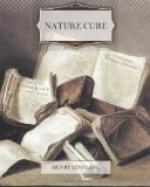“One notable example is typhoid fever. At the outset of the nineteenth century it was treated with ‘remedies’ of the extremest violence—bleeding and blistering, vomiting and purging, and the administration of antimony and mercury, and plenty of other heroic remedies. Now the patient is bathed and nursed and carefully tended, but rarely given medicine. This is the result partly of the remarkable experiments of the Paris and Vienna schools in the action of drugs, which have shaken the stoutest faiths; and partly of the constant and reproachful object lesson of homeopathy. No regular physician would ever admit that the homeopathic preparations, ‘infinitesimals,’ could do any good as direct curative agents; and yet it was perfectly certain that homeopaths lost no more of their patients than others. There was but one conclusion to draw—that most drugs had no effect whatever on the diseases for which they were administered.”
Dr. Osler is probably the greatest medical authority on drugs now living. He was formerly professor of materia medica at the Johns Hopkins University of Baltimore, U. S., and now holds a professorship at Oxford University, England. His books on medical practice are in use in probably every university and medical school in English-speaking countries. His views on drugs and their real value as expressed in this article should be an eye-opener to those good people who believe that we of the Nature Cure school are altogether too radical, extreme, and somewhat cranky.
However, what Dr. Osler says regarding the “New School” is true only of a few advanced members of the medical profession.
On the rank and file, the idea of drugless healing has about the same effect as a red rag on a mad bull. There are still very few physicians in general practice today who would not lose their bread and butter if they attempted to practice drugless healing on their patients. Both the profession and the public will need a good deal more education along Nature Cure lines before they will see the light.
In the second sentence of his article, Dr. Osler admits the efficacy of mental therapeutics and therapeutic faith as a “curative agent,” and ascribes the good effects of medicine to their stimulating influence upon the patient’s mind rather than to any beneficial action of the drugs themselves.
With regard to the origin of the modern treatment of typhoid fever, however, the learned doctor is either misinformed or he misrepresents the facts. The credit for the introduction of hydropathic treatment of typhoid fever does not belong to the “remarkable experiments of the Paris and Vienna schools.” These schools and the entire medical profession fought this treatment with might and main. For thirty years Priessnitz, Bilz, Ruhne, Father Kneipp and many other pioneers of Nature Cure were persecuted and prosecuted, dragged into the courts and tried on the charges of malpractice and manslaughter for using their sane and natural methods. Not until Dr. Braun of Berlin wrote an essay on the good results obtained by the hydropathic treatment of typhoid fever and it had in that way received orthodox baptism and sanction, was it adopted by advanced physicians all over the world.




